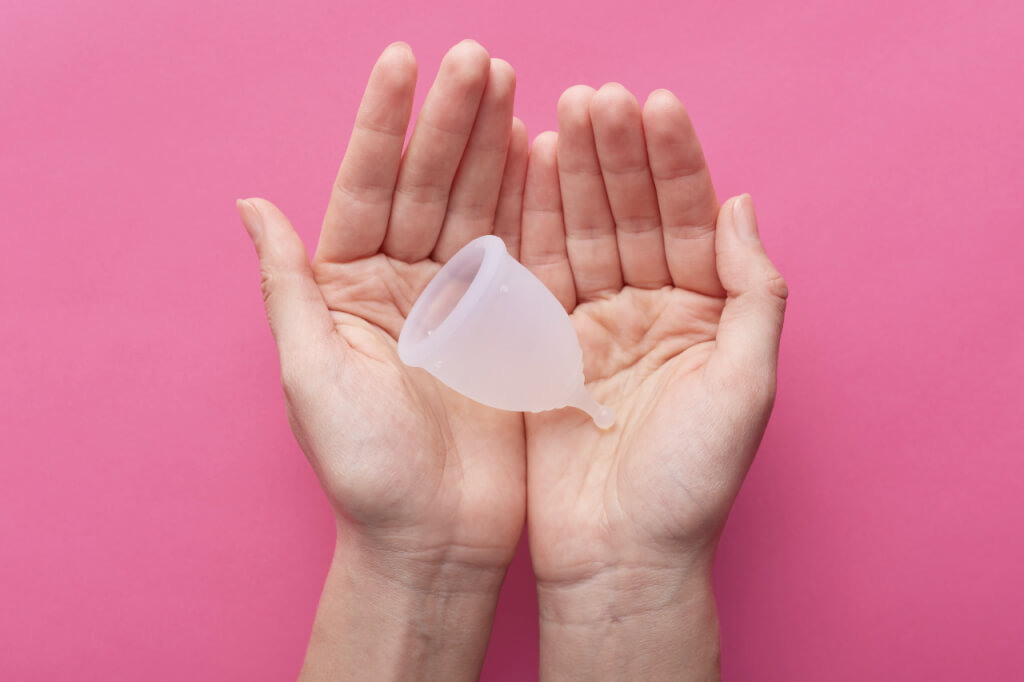Advertising Disclosure
Menstrual cups: what you need to know

More than ever, there are many different menstrual products available. Pads and tampons are still the most common, but there are alternative options like period underwear and reusable cloth pads. Perhaps the most talked about alternative is the menstrual cup. Over the last few years, cups have been growing in popularity but remain a highly debated product. There’s a lot of confusion over how to use cups and debate over their pros and cons. If you’re wondering whether menstrual cups are right for you, here’s everything you need to know.
WHAT ARE MENSTRUAL CUPS?
A menstrual cup is a small, funnel-like cup, usually silicone or rubber, that folds and inserts into the vagina to catch period fluid. There are both reusable and disposable cups. And although it may sound like a new invention, menstrual cups have been around since the 1800s. In recent years, cups have gained popularity for being eco-friendly and convenient. Though a lot of people are still on the fence about using menstrual cups, their popularity is only growing, with the global market predicted to hit $1.49 billion by 2026.
HOW DO MENSTRUAL CUPS WORK?
Unlike tampons or pads which absorb period blood, a menstrual cup collects it. To insert the cup, tightly fold it and insert it the same way you would insert a tampon. If you feel the cup, that is a sign that you inserted it incorrectly, as you shouldn’t be able to feel it. With proper insertion, the cup will open up and rest inside. It is completely normal if you need to rotate the cup and adjust it to get it to open. The cup rests inside, forming a seal that prevents any leaks, allowing blood to drip directly into it.
PROS OF USING MENSTRUAL CUPS
ECO-FRIENDLINESS
Because these cups are reusable, they produce less waste, and that makes them better for the environment. While other period hygiene products are made mostly of paper, menstrual cups are not, which means fewer trees are sacrificed. Another eco-friendly plus.
WALLET-FRIENDLINESS
The reusable aspect of these cups is also beneficial for saving you money. Constantly buying pads and tampons adds up, with many individuals spending at least $100 a year on them. If you choose a reusable cup, this is an already affordable investment, as some cups can last up to 1o years.
TIME EFFICIENCY
You can leave a menstrual cup in for much longer than you can leave in a tampon in. A menstrual cup can stay inside the vagina safely for up to 12 hours before having to be emptied, due to the fact that they hold more blood than a typical tampon. Tampons need changing every four to eight hours.
COMFORT
Many menstrual cup users report that cups are more comfortable than alternatives. This is in part because cups don’t tend to cause vaginal dryness, which tampons often do. Other users also report fewer cramps after using menstrual cups, but this may be different from person to person.
CONS OF USING MENSTRUAL CUPS
MESSINESS (AT FIRST)
Menstrual cups can be messy when you first start using them. And many users feel grossed out when touching their own blood. According to OB-GYN Dr. Jyothi Parapurath, “Menstrual cup usage has a learning curve, like anything else.” New users are also more likely to experience leaks due to inserting the cup incorrectly.
DISCOMFORT
Discomfort is another con that is common for new users. Inserting in the cup improperly can easily lead to some discomfort. A menstrual cup could also be uncomfortable if it is the wrong size, since many users don’t take into account that there are different sizes available, or may not know their correct size.
MENSTRUAL CUP OPTIONS
DIVA CUP
Diva Cup is the brand that popularized menstrual cups among millennials. The Diva Cup comes in three versions: Model 0, Model 1 and Model 2. Each version is for people in specific age ranges. Model 0 is for ages 18 and under; Model 1 is for those between the ages 19 and 30 with a medium flow; and Model 2 is for those over the age of 30 or with a heavy flow. The Diva Cup is chemical-free and made with medical-grade silicone.
CORA CUP
The Cora Cup is a great choice for beginners. Cora describes their cup as the “most comfortable and simple-to-use cup, possibly ever.” The Cora Cup has flat sides that instruct you where to place your fingers, and its slightly irregular shape makes folding and removing the cup easier.
SOFTCUP
A disposable menstrual cup is an excellent option if you don’t want to commit to using a cup. Softcup’s disposable discs come in packages of 14 and are available through Amazon and Target. Though these cups are disposable like tampons and pads, they can still stay inside for up to 12 hours. Another plus? They claim to hold the equivalent of five tampons.
SAALT
As one of the gentlest cups on the market, the Saalt menstrual cup is an ideal choice for those who are sensitive. The cup is made with hypoallergenic, BPA-free and nontoxic silicone. It’s an especially good choice for those with bladder or vaginal sensitivity and anyone who’s “had discomfort with firmer cups.” Saalt claims its vegan and cruelty-free menstrual cup can last up to 10 years.
If you are looking into getting a menstrual cup, remember to do your research and take sizing into account. When deciding whether or not a menstrual cup is right for you, you should consult your gynecologist. You and your doctor can also work together to determine your correct menstrual cup size. With tons of options available to you — reusable cups, disposable cups and cups made from different materials — there is probably a menstrual cup available to serve your particular needs.








